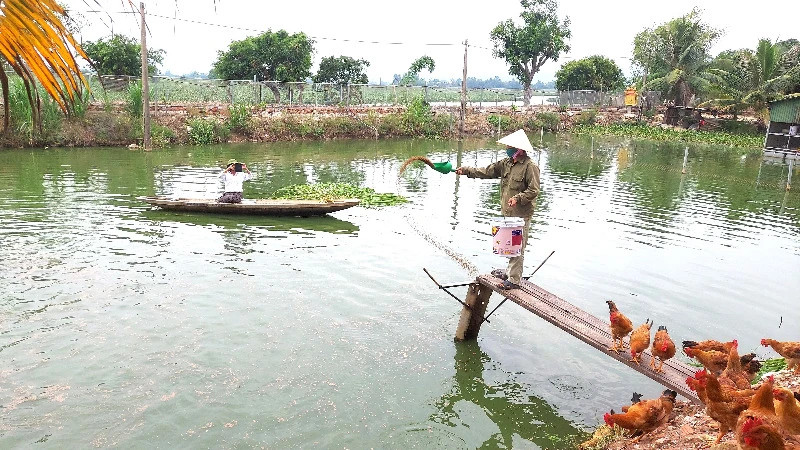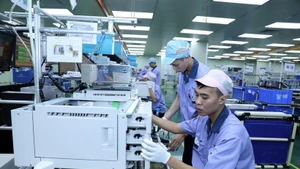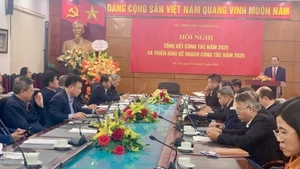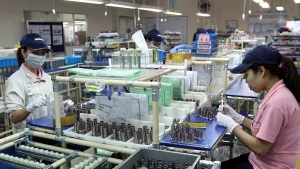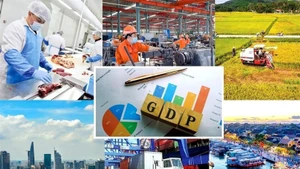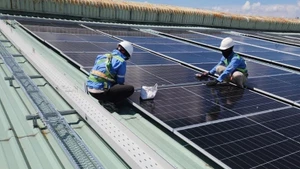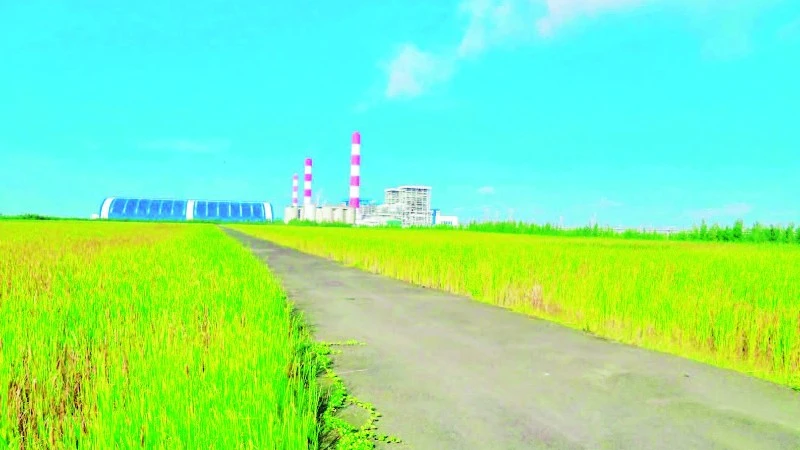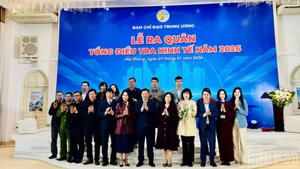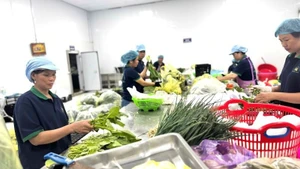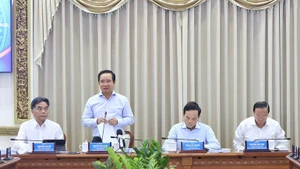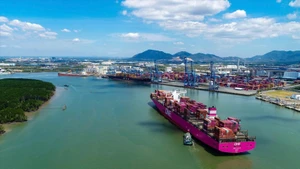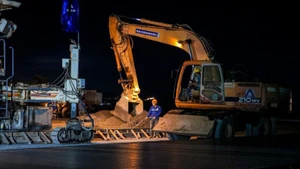Quang Binh has supported the development of circular agricultural models, thus bringing economic efficiency while contributing to reducing greenhouse gas emissions and protecting the environment.
Circular livestock farming, improved rice cultivation
Circular livestock farming is understood as a production activity with a closed cycle, applying traditional techniques and scientific advances to process by-products and waste in the livestock farming process into useful values, contributing to environmental protection. One of the pioneers in developing circular farming in Quang Binh is Mr. Nguyen Van Hoang of Vo Ninh Commune, Quang Ninh District.
Mr. Hoang’s farm covers an area of more than 2 hectares and was built in the middle of the commune's low-lying fields, so it took a lot of effort to create a solid barn system. It is worth mentioning that, in an area that is often flooded, the barn that Mr. Hoang designed features a high loft where poultry can be kept during flood days, without having to move them to another area. He also fenced around the fishponds with iron nets to prevent the aquatic products from being swept away by the water during floods.
Hoang said he is investing in raising 1,700 native chickens, 28 crossbred cows, and freshwater fishponds according to the circular farming model. Different from traditional farming methods, circular farming simultaneously applies technical measures to organise production in a closed cycle.
Specifically, the farm grows VA06 grass to feed the cows and fish; a part of the composted cow manure is used as substrate and feed for earthworms; the earthworms are then used as supplementary feed for the chickens and fish; the remaining cow manure, along with composted chicken manure and earthworm manure, is used to fertilise the VA06 grass. During the production process, waste is thoroughly treated and utilised, limiting its release into the environment while reducing feed costs, improving production efficiency, and contributing to protecting human health.
When implementing the model, the farm received partial funding from the Quang Binh Provincial Agricultural and Fisheries Extension Centre to purchase chicken, fish, and earthworm breeds, and access technical guidance for each type of crop and livestock in a closed cycle to ensure productivity and efficiency.
Thanks to the combination of green food (grass), protein-rich food (earthworms) and industrial food, and a spacious and clean living environment, the livestock quickly increases in weight, ensuring good quality meat. On average, every 3.5 months, he sells a batch of broiler chickens to traders right at the farm. Meat fish are also continuously intercropped, even at the present time when Quang Binh is entering the rainy season.
The garden-pond-cage model is considered the simplest form of circular agriculture, combining cultivation with livestock farming, limiting waste, following nature and completely in line with the principles of the circular economy. In Quang Binh, more and more garden-pond-cage-biogas, garden-pond-cage-forest, garden-pond-lake models are appearing, which are improved to suit the level of agricultural production development as well as the ecological conditions of each locality. These agricultural models not only bring high economic efficiency but also help reduce greenhouse gas emissions.
Tran Thanh Hai, Director of the Quang Binh Province Agricultural Extension Centre
In addition, according to the Department of Agriculture and Rural Development of Quang Binh Province, for many years now, farmers have been implementing the improved rice cultivation technique (SRI) — a technical advancement recognised by the Ministry of Agriculture and Rural Development since 2007.
The implementation process shows that the improved SRI cultivation system is well received by rice growers because it is an advanced rice production technique, environmentally friendly, reducing the amount of irrigation water, seeds, fertilisers, pesticides, and labour by 40-50%, while at the same time reducing greenhouse gas emissions compared to traditional rice production methods.
Recently, in Quang Binh, additional models of “rice-shrimp”, “rice-fish” are being implemented in low-lying, often-flooded areas in the districts of Quang Ninh, Le Thuy and Quang Trach. Under this model, when raising shrimp or fish in rice fields, the shrimp and fish manure and their leftover food are used as fertiliser to supplement nutrients for rice plants. Conversely, after harvesting rice, farmers release shrimp and fish into the fields, and the stubble and plankton in the fields become food sources for aquatic products.
With this rotation model, crops and livestock need to use almost no pesticides nor antibiotics, creating clean products and protecting the environment. The “rice-shrimp” and “rice-fish” models are widely implemented in Quang Binh to reduce diseases, reduce environmental pollution, create safe products, and especially to help farmers increase their income by 5-7 times on the same unit of area compared to only growing rice.
Solutions to reduce greenhouse gas emissions
According to the National Agricultural Extension Centre, in Vietnam, the agricultural sector accounts for about 30% of the total national greenhouse gas emissions. Rice is an important agricultural product in Vietnam but accounts for 48% of the agricultural sector's greenhouse gas emissions and more than 75% of methane emissions, equivalent to about 49.6 million tons of greenhouse gas emissions per year.
Given this situation, in recent years, the National Agricultural Extension Centre has coordinated and supported localities to deploy several agricultural production models applying technical advances to replicate them in order to reduce greenhouse gas emissions, protect the environment, and contribute to sustainable agricultural development.
The Quang Binh Provincial People's Committee has issued an action plan on reducing methane emissions by 2030, with specific targets to contribute to the national target of reducing emission levels by at least 30% compared to 2020. The province also issued a project on organic agriculture development for the 2020-2030 period as well as a plan to implement the strategy for sustainable agricultural and rural development for the 2021-2030 period.
With that goal, in recent times, businesses, cooperatives and farmers in Quang Binh have implemented many models of circular agricultural production, organic agriculture, high technology, and so on, which have initially brought about efficiency, while the products have been welcomed by society as well as the market. However, the lack of awareness of people and business owners about emission reduction agriculture and circular agriculture, and the lack of financial and land support policies from the state, has greatly affected this new field.
According to Le Minh Linh, Deputy Director of the National Agricultural Extension Centre, to reduce greenhouse gas emissions in the agricultural sector, the state needs to devise policies to support finance, land, and resources to develop agriculture to reduce greenhouse gas emissions; and at the same time, strengthen propaganda, raise awareness, and transfer technical advances and new technologies in agricultural production to reduce greenhouse gas emissions and propose appropriate processes and standards for each subject, field, and region. Localities and enterprises have organised production in the direction of linking cooperatives, cooperatives, enterprises and agricultural producers, processing and consuming products to create a circular chain.
Tran Thanh Hai, Director of the Quang Binh Province Agricultural Extension Centre, said that in order to create excitement and encourage and guide businesses and farmers to participate in circular agricultural production and organic agriculture in the coming time, authorities at all levels and the agricultural sector must support and connect with each other to expand the consumption market for circular agricultural products, creating competitive advantages for businesses and farmers participating in this model.
At the same time, Quang Binh also needs to have policies to encourage the application of organic and safe agricultural practices to increase productivity and product value; reduce negative impacts on the environment; and protect the ecosystem and human health.
